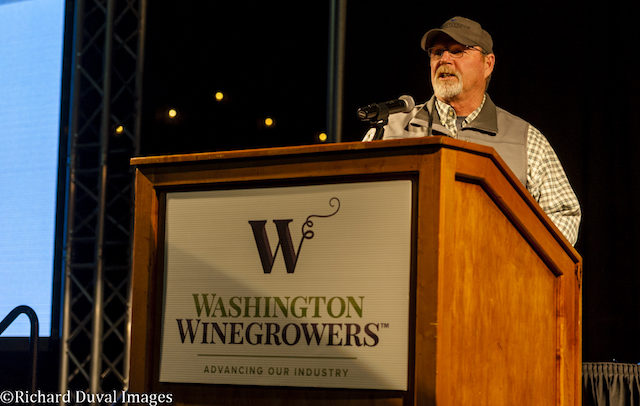
BENTON CITY, Wash. — It’s an oft-repeated adage that great wine is made in the vineyard. If it’s true, then Marshall Edwards was certainly the best wine maker in Washington last year.
Named 2016 Grower of the Year award by the Washington Winegrowers (formerly the Washington Association of Wine Grape Growers), Edwards is the vineyard operations manager for Shaw Vineyards and Northwest Vineyard Management. He oversees Quintessence and Shaw vineyards on Red Mountain, among regarded in the top tier of Washington vineyards. His team also manages Obelisco, a 30-acre vineyard that produces grapes for Doug Long’s Obelisco Estate.
The list of highly acclaimed wines that reflect Edwards’ talent and expertise reads akin to an honor roll of Washington’s best — Col Solare, DeLille, Duckhorn, Fidelitas, Gorman, Guardian, Januik, JM Cellars, Obelisco and Mark Ryan. But big or small, superstar or rising star, each winery receives the attention and devotion to quality that are Edwards’ hallmarks.
“There are certain people you come across in the industry over the span of your career who just ‘Get it’ — Marshall Edwards is one of those people,” said Charlie Hoppes, Fidelitas owner/winemaker. “He just intuitively knows what to do in every situation and challenge that comes his way. The proof for me is always how the wine ends up tasting. We have made exceptional wines over many vintages that are direct result of Marshall and his team.”
Fascination with soils inspire Edwards
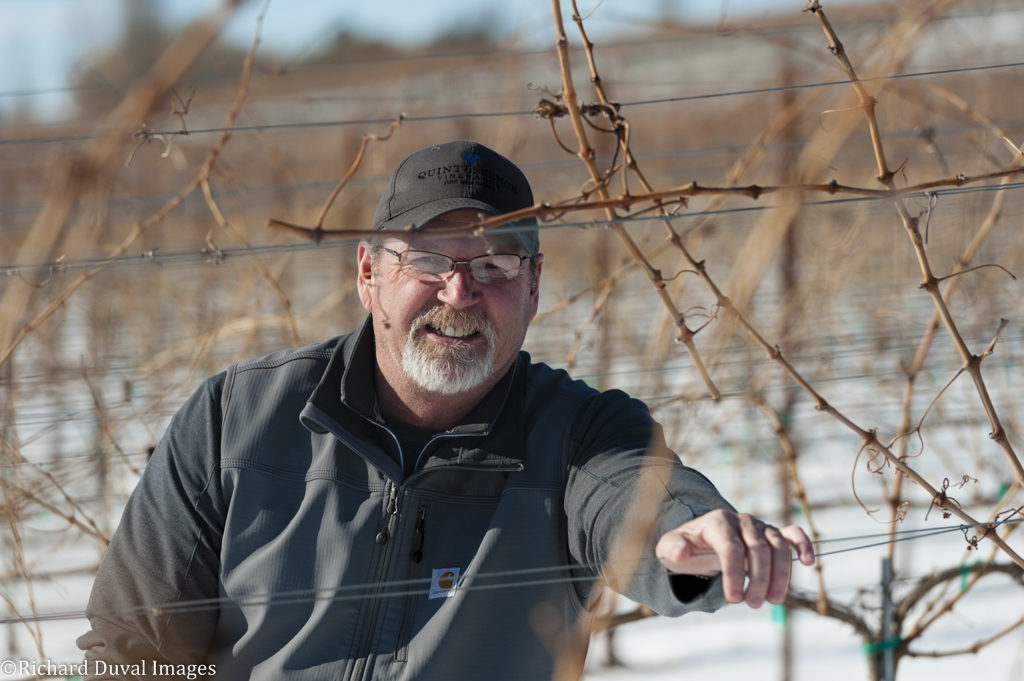
Early bud break, spring freeze, surprise rain storms — Mother Nature throws a lot of curve balls throughout the growing season. Edwards handles each change with steady “hand on the till” calm that underscores his farmer’s DNA.
“Marshall asks a lot of questions. He really tries to understand what the winemaker wants to achieve with the fruit,” said Hillary Sjolund, Sonoris owner/winemaker. “He’s faced a lot of challenges with young vines coming into production during very warm growing seasons. There is a lot of soil complexity in the sites he manages, and he has taken risks in planting new clones that interest winemakers. Despite any adversity in the growing season, Marshall faces it head-on with confidence and a smile.”
The truth is this man knows his dirt.
“The ground is where it starts for me,” Edwards said. “I love to grow. I started on a dryland wheat ranch and now grapes. I see a patch of earth and almost subconsciously, I’m thinking of what to grow and how to grow it. I have it all plotted in my head long before we turn the first spade.”
It’s this hands-on and in the ground that makes the affable Edwards a great winegrower, said Earl Sullivan, owner/winemaker of Telaya Wine Co., in the Boise bedroom community of Garden City, Idaho.
“He knows his vineyards. He knows the plants, the terrain, the soil,” Sullivan said. “He anticipates what they need and really cares for the vineyard. And, he engages with the winemakers. He’s gracious, knowledgeable, respectful of our wineries. It’s a great combination. We learn a ton listening to him.”
Red Mountain diversity, heat presents challenges
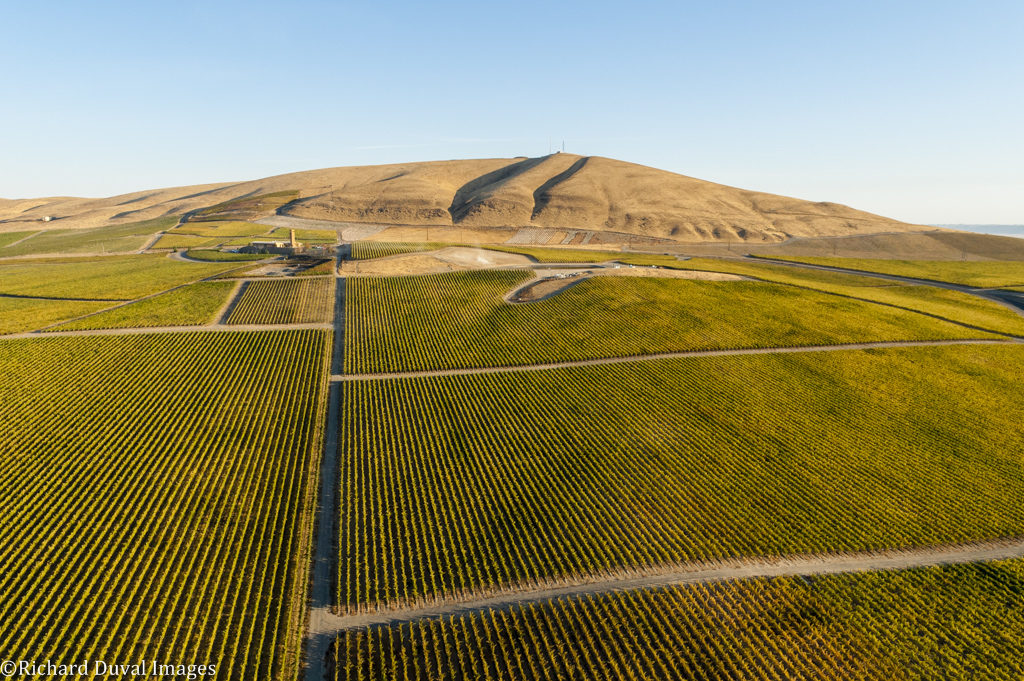
Red Mountain’s reputation is as a producer of grapes of nearly unsurpassed quality thanks in large part to the collection of growers such as Dick Boushey, Jim Holmes, Damon LaLonde and the Williams family. It’s not easy considering the challenges of the AVA – extreme heat units and the wide range of soil types.
Edwards’ skill at balancing soil and weather with winemaker expectations makes him “the perfect combination of Old World artisan and New World technologist in his approach to wine growing,” said JM Cellars owner/winemaker John Bigelow.
“Red Mountain is unique because the soils and geology are different every five feet,” Bigelow added. “You have to spend far more time walking the rows and digging in the dirt than maybe anywhere in the state. The good news for winemakers is that is what Marshall loves to do.”
Edwards’ approach to growing and maintaining Quintessence, Obelisco and Shaw Estates stems directly from the challenges of working Red Mountain, balancing extreme heat with the aim to let the fruit develop with balanced sugar and acids. Premium grapes come with a premium price, so expectations are high. He relies on his farmer’s eye and experience to guide the growth, but he’s not averse to using new tools and technology.
“It’s about balance,” Edwards noted. “Mechanization is huge, and we’re using it more often. But at the same time, we still need the people touch to ensure quality. That’s what makes Red Mountain wines so coveted – that hands-on touch. We won’t ever move away from that.”
Edwards’ career takes off as Cold Creek manager
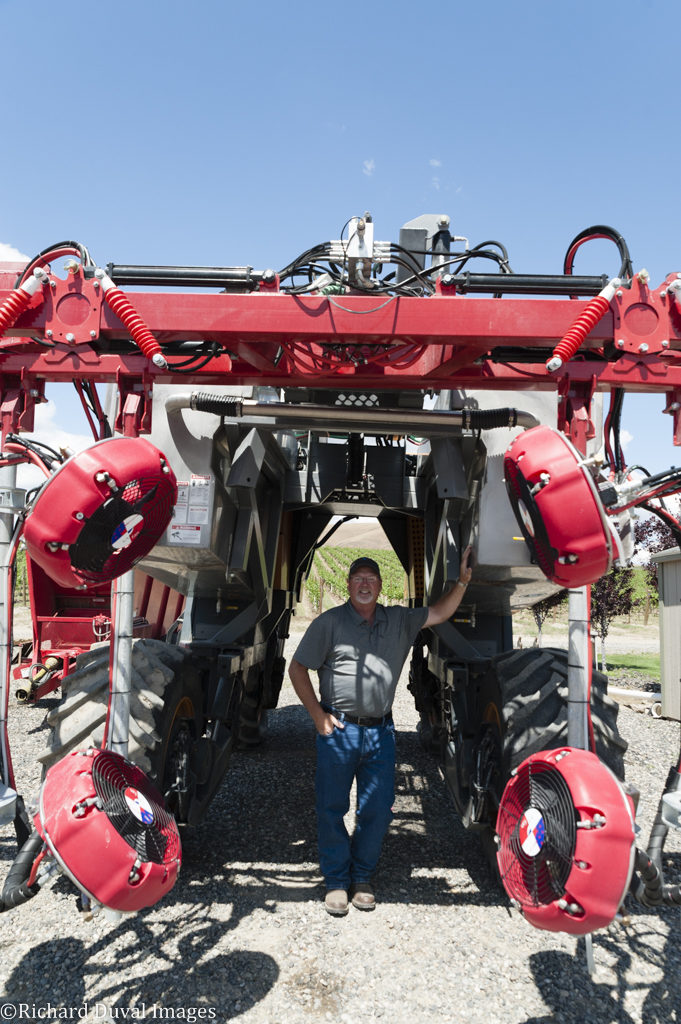
In three decades as a grower, his touch with a vineyard is evidenced in some of Washington’s largest vineyards. He honed his skills at Ste. Michelle Wine Estates’ Canoe Ridge Estate in the Horse Heaven Hills in 1991 under the tutelage of Mimi Nye (who was named Grower of the Year in 2015) and Jerry DeCoto.
In 2002, Edwards transferred to Cold Creek Vineyard as vineyard manager, working with Ron Bunnell, then head winemaker for Chateau Ste. Michelle. Edwards came into his own as a winegrower during his Cold Creek stint, taking the vineyard from 500 to 700 acres and establishing it a premier site for Cabernet Sauvignon. Cold Creek remains his favorite vineyard site.
“Beautiful vineyard, great people,” he mused fondly. “I learned so much from my time there. Jerry taught me how to lay out a vineyard properly; Pedro Flores showed me the smart way to manage a vineyard. Though Ste. Michelle was big and thriving, they never embraced a ‘corporate farming’ philosophy. They let us take the time to learn the land and develop it toward growing its best grapes.”
His success at Cold Creek caught the eye of Dick Shaw who, with general manager Eric Henriksen, was busy growing Quintessence and planning Shaw Estates to be premiere growing sites. Shaw knew both projects needed a viticulturist with not only broad vineyard expertise but also skilled at working within the demanding standards of the winemaking community that had set its winemaking fortunes on Red Mountain.
In Edwards, they got both.
“Marshall is a great grower because of his knowledge of the business and his relationships with the people in the industry,” said co-owner Wendy Shaw. “He’s easy to work with – a good listener with good ideas. The biggest challenge for any vineyard manager is the relationship with the client and being able to handle their requests. Everyone likes Marshall.”
Sullivan of Telaya echoed what every winemaker said about working with Edwards — “we’ve never had a concern about our fruit because he is so proactive in the vineyard.”
Shaw recruits Edwards for Red Mountain
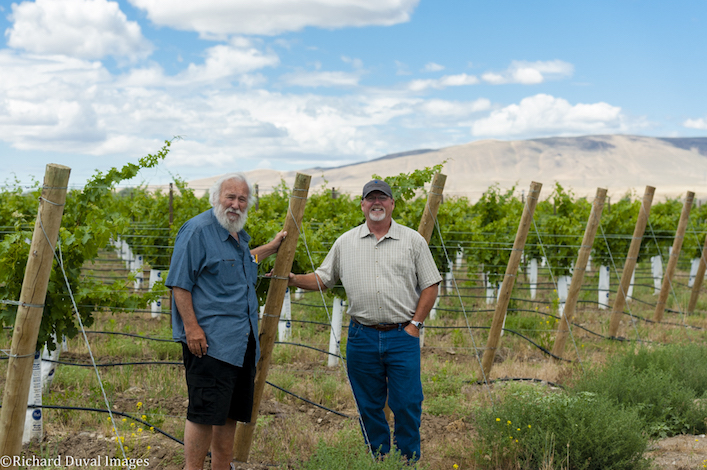
For Edwards, working with the Shaws was an opportunity to plan and grow a vineyard from stage one. Like most, he was attracted to Red Mountain’s growing reputation and status.
“I love Red Mountain, and I liked putting in vineyards,” Edwards said. “As much as I loved Ste. Michelle, this was a chance to for me to get back to farming.”
In Shaw, Edwards found a kindred spirit who shared his penchant for growth without sacrificing quality. Shaw — whose shuffling, self-depreciating demeanor masks one of the shrewdest minds in the wine industry — knows the intrinsic value of positioning his vineyards as sources of premier grapes.
“This is a special area, and we’re looking forward to having more people who want to see our country,” Shaw told Great Northwest Wine two years ago. “The more people see it, the more they will want to buy Red Mountain wine.”
Edwards marvels at Shaw’s mastery of the details of vineyard management.
“When you go into a meeting with Dick, you had better know what you’re talking about because he does,” Edward said. “He has one of the sharpest minds I’ve ever encountered – he figures circles round most people. It’s all in his head.”
Shaw’s penchant for the details combined with Edward’s systematic approach to vineyard management exemplifies teamwork in full view.
“Dick champions the specialness of Red Mountain,” Edwards said. “To him, that means we have to consistently deliver above expectations. But at the same time, this is a business with a bottom line. He pushes us to try new ways to control costs but increase quality; all he asks is ‘Be smart.’ ”
Edwards shares ‘Let’s get going’ approach
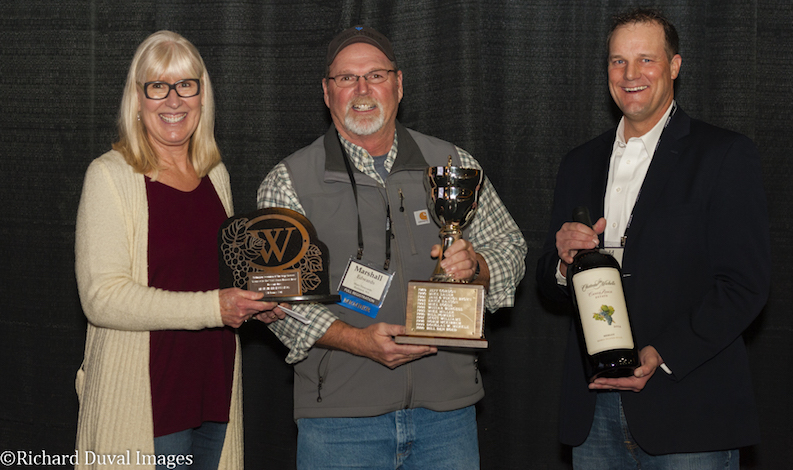
Shaw’s emphasis on strong relations with the winemaking community is underscored each spring when some of the state’s top winemakers visit Red Mountain for a first-hand update by Edwards and his team on vineyard progress and changes. Numbers are crunched, stories are shared, wines are sampled. Edwards makes a point to spend time with each visiting winemaker, asking questions and listening to their expectations.
“Clearly he is a partner in our winemaking,” said Chris Gorman, owner/winemaker who buys Cabernet Sauvignon grapes from Quintessence, Shaw and Obelisco. “Dealing with 40 wineries and winemakers could raise your blood pressure a bit, but he maintains his cool under a very stressful time like harvest. We can’t do it without him. I call him ‘The Grape Whisperer.’ ”
Praise from winemaking clients is the ultimate compliment, Edwards said.
“When I hear ‘This was the best fruit I got in the winery this year,’ that means we hit it out of the park,” Edwards said. “It never gets old sharing that with the team.”
Sparked by Shaw’s relentless drive to grow, Edwards is not lacking for new challenges. Horn Rapids, a 600-acre vineyard north of Red Mountain as well as a new project in Horse Heaven Hills offer him new palettes for his particular art.
“Shaw Vineyards will never stop growing,” Edwards predicts. “Dick is always looking, always thinking. He loves looking at new ground! One of the best moments of my day is when the phone rings and it’s Dick saying, ‘Hey, let’s go look at this ground I’m thinking about. I want to know what you think. Let’s get going.’
“That’s our philosophy around here – let’s get going.”

Leave a Reply